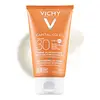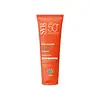What's inside
What's inside
 Key Ingredients
Key Ingredients

 Benefits
Benefits

 Concerns
Concerns

 Ingredients Side-by-side
Ingredients Side-by-side

Octocrylene 7%
UV AbsorberTitanium Dioxide 4.15%
Cosmetic ColorantButyl Methoxydibenzoylmethane 3%
UV AbsorberDrometrizole Trisiloxane 2.5%
UV AbsorberTerephthalylidene Dicamphor Sulfonic Acid 0.5%
UV AbsorberWater
Skin ConditioningGlycerin
HumectantC12-15 Alkyl Benzoate
AntimicrobialAlcohol Denat.
AntimicrobialPropylene Glycol
HumectantCyclopentasiloxane
EmollientNylon-12
Stearic Acid
CleansingPotassium Cetyl Phosphate
EmulsifyingTriethanolamine
BufferingPalmitic Acid
EmollientCetyl Alcohol
EmollientGlyceryl Stearate
EmollientPEG-100 Stearate
Dimethicone
EmollientPoly C10-30 Alkyl Acrylate
Emulsion StabilisingEthylhexylglycerin
Skin ConditioningAluminum Hydroxide
EmollientAcrylates/C10-30 Alkyl Acrylate Crosspolymer
Emulsion StabilisingTocopherol
AntioxidantGlycine Soja Oil
EmollientSilica
AbrasiveHydroxypropyl Methylcellulose
Emulsion StabilisingDisodium EDTA
Benzyl Benzoate
AntimicrobialBenzyl Alcohol
PerfumingOctocrylene 7%, Titanium Dioxide 4.15%, Butyl Methoxydibenzoylmethane 3%, Drometrizole Trisiloxane 2.5%, Terephthalylidene Dicamphor Sulfonic Acid 0.5%, Water, Glycerin, C12-15 Alkyl Benzoate, Alcohol Denat., Propylene Glycol, Cyclopentasiloxane, Nylon-12, Stearic Acid, Potassium Cetyl Phosphate, Triethanolamine, Palmitic Acid, Cetyl Alcohol, Glyceryl Stearate, PEG-100 Stearate, Dimethicone, Poly C10-30 Alkyl Acrylate, Ethylhexylglycerin, Aluminum Hydroxide, Acrylates/C10-30 Alkyl Acrylate Crosspolymer, Tocopherol, Glycine Soja Oil, Silica, Hydroxypropyl Methylcellulose, Disodium EDTA, Benzyl Benzoate, Benzyl Alcohol
Water
Skin ConditioningDiisopropyl Adipate
EmollientDiethylamino Hydroxybenzoyl Hexyl Benzoate
UV FilterDicaprylyl Ether
EmollientSilica
AbrasiveEthylhexyl Triazone
UV AbsorberC12-15 Alkyl Benzoate
AntimicrobialBis-Ethylhexyloxyphenol Methoxyphenyl Triazine
Skin ConditioningHydrogenated Vegetable Oil
EmollientDiethylhexyl Butamido Triazone
UV AbsorberBeheneth-25
CleansingPropanediol
SolventPentylene Glycol
Skin ConditioningAcrylates/C12-22 Alkyl Methacrylate Copolymer
Niacinamide
SmoothingHydroxyethyl Acrylate/Sodium Acryloyldimethyl Taurate Copolymer
Emulsion StabilisingCetearyl Alcohol
EmollientPolyester-7
Skin ConditioningCoco-Glucoside
CleansingMicrocrystalline Cellulose
AbsorbentNeopentyl Glycol Diheptanoate
Emollient1,2-Hexanediol
Skin ConditioningCaprylyl Glycol
EmollientGlycerin
HumectantArginine
MaskingCitric Acid
BufferingTocopherol
AntioxidantCellulose Gum
Emulsion StabilisingPolysorbate 60
EmulsifyingSorbitan Isostearate
EmulsifyingDisodium Lauryl Sulfosuccinate
CleansingGlycine Soja Oil
EmollientLecithin
EmollientLepidium Sativum Sprout Extract
Skin ConditioningWater, Diisopropyl Adipate, Diethylamino Hydroxybenzoyl Hexyl Benzoate, Dicaprylyl Ether, Silica, Ethylhexyl Triazone, C12-15 Alkyl Benzoate, Bis-Ethylhexyloxyphenol Methoxyphenyl Triazine, Hydrogenated Vegetable Oil, Diethylhexyl Butamido Triazone, Beheneth-25, Propanediol, Pentylene Glycol, Acrylates/C12-22 Alkyl Methacrylate Copolymer, Niacinamide, Hydroxyethyl Acrylate/Sodium Acryloyldimethyl Taurate Copolymer, Cetearyl Alcohol, Polyester-7, Coco-Glucoside, Microcrystalline Cellulose, Neopentyl Glycol Diheptanoate, 1,2-Hexanediol, Caprylyl Glycol, Glycerin, Arginine, Citric Acid, Tocopherol, Cellulose Gum, Polysorbate 60, Sorbitan Isostearate, Disodium Lauryl Sulfosuccinate, Glycine Soja Oil, Lecithin, Lepidium Sativum Sprout Extract
 Reviews
Reviews

Ingredients Explained
These ingredients are found in both products.
Ingredients higher up in an ingredient list are typically present in a larger amount.
C12-15 Alkyl Benzoate is made up of Benzoic Acid and long chain alcohols. It has a low molecular weight.
C12-15 Alkyl Benzoate is an emollient and texture enhancer. Due to its solubility, it is often used in sunscreens to help evenly distribute active ingredients.
As an emollient, C12-15 Alkyl Benzoate helps soften and hydrate your skin. Emollients create a film on your skin that traps moisture within.
This ingredient has been reported to cause eye irritation.
Learn more about C12-15 Alkyl BenzoateGlycerin is already naturally found in your skin. It helps moisturize and protect your skin.
A study from 2016 found glycerin to be more effective as a humectant than AHAs and hyaluronic acid.
As a humectant, it helps the skin stay hydrated by pulling moisture to your skin. The low molecular weight of glycerin allows it to pull moisture into the deeper layers of your skin.
Hydrated skin improves your skin barrier; Your skin barrier helps protect against irritants and bacteria.
Glycerin has also been found to have antimicrobial and antiviral properties. Due to these properties, glycerin is often used in wound and burn treatments.
In cosmetics, glycerin is usually derived from plants such as soybean or palm. However, it can also be sourced from animals, such as tallow or animal fat.
This ingredient is organic, colorless, odorless, and non-toxic.
Glycerin is the name for this ingredient in American English. British English uses Glycerol/Glycerine.
Learn more about GlycerinGlycine Soja Oil comes from the soybean. Glycine Soja is native to eastern Asia.
Soybean oil is an emollient. It is rich in antioxidants and fatty acids including palmitic, stearic, oleic, and linoleic acids.
As an emollient, the fatty acids in soybean oil helps keep your skin soft and hydrated. It does so by creating a film on top that traps moisture in.
Soybean oil is also rich in vitamin E, a potent antioxidant. Vitamin E is also anti-inflammatory and provides a soothing effect.
Studies show soy may help fade hyperpigmentation from UVB. It does so by disrupting the melanin process from UVB induced skin inflammation.
This ingredient may not be malassezia folliculitis, or fungal-acne, safe.
Soybeans are rich in proteins and are part of the legume family. Foods made with soybeans include tofu, soymilk, edamame, miso, and soy sauce.
Learn more about Glycine Soja OilSilica, also known as silicon dioxide, is a naturally occurring mineral. It is used as a fine, spherical, and porous powder in cosmetics.
Though it has exfoliant properties, the function of silica varies depending on the product.
The unique structure of silica enhances the spreadability and adds smoothness, making it a great texture enhancer.
It is also used as an active carrier, emulsifier, and mattifier due to its ability to absorb excess oil.
In some products, tiny microneedles called spicules are made from silica or hydrolyzed sponge. When you rub them in, they lightly polish away dead skin layers and enhance the penetration of active ingredients.
Learn more about SilicaTocopherol (also known as Vitamin E) is a common antioxidant used to help protect the skin from free-radicals and strengthen the skin barrier. It's also fat soluble - this means our skin is great at absorbing it.
Vitamin E also helps keep your natural skin lipids healthy. Your lipid skin barrier naturally consists of lipids, ceramides, and fatty acids. Vitamin E offers extra protection for your skin’s lipid barrier, keeping your skin healthy and nourished.
Another benefit is a bit of UV protection. Vitamin E helps reduce the damage caused by UVB rays. (It should not replace your sunscreen). Combining it with Vitamin C can decrease sunburned cells and hyperpigmentation after UV exposure.
You might have noticed Vitamin E + C often paired together. This is because it is great at stabilizing Vitamin C. Using the two together helps increase the effectiveness of both ingredients.
There are often claims that Vitamin E can reduce/prevent scarring, but these claims haven't been confirmed by scientific research.
Learn more about TocopherolWater. It's the most common cosmetic ingredient of all. You'll usually see it at the top of ingredient lists, meaning that it makes up the largest part of the product.
So why is it so popular? Water most often acts as a solvent - this means that it helps dissolve other ingredients into the formulation.
You'll also recognize water as that liquid we all need to stay alive. If you see this, drink a glass of water. Stay hydrated!
Learn more about Water